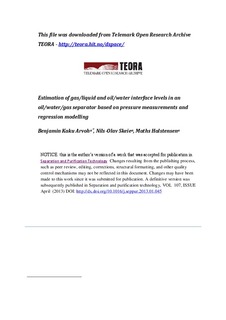| dc.contributor.author | Arvoh, Benjamin Kaku | |
| dc.contributor.author | Skeie, Nils-Olav | |
| dc.contributor.author | Halstensen, Maths | |
| dc.date.accessioned | 2014-03-24T14:35:59Z | |
| dc.date.accessioned | 2017-04-19T12:49:59Z | |
| dc.date.available | 2014-03-24T14:35:59Z | |
| dc.date.available | 2017-04-19T12:49:59Z | |
| dc.date.issued | 2013-02-08 | |
| dc.identifier.citation | Arvoh, Benjamin Kaku, Skeie, Nils-Olav, & Halstensen, Maths. (2013). Estimation of gas/liquid and oil/water interface levels in an oil/water/gas separator based on pressure measurements and regression modelling. Separation and Purification Technology, 107(0), 204-210. | |
| dc.identifier.issn | 0332-7353 | |
| dc.identifier.uri | http://hdl.handle.net/11250/2438436 | |
| dc.description.abstract | Gravity separators are widely used for separation of gas/oil/water/sand from both offshore and onshore oil production facilities. Estimation of the gas/liquid and oil/water interface levels in gravity separators have been a concern since these parameters are important for reliable operation. Most of the instruments on the market today do not provide reliable measurements of both gas/liquid and oil/water interface levels. The few instruments that do provide reliable measurements are however based on radioactive principles. Nevertheless these radioactive instruments possess a strong health, safety and environmental risk. An alternative inexpensive, environmentally friendly, accurate and cost effective way for gas/liquid and oil/water interface level estimation based on pressure measurement is presented. The root mean squared error of prediction (RMSEP) for gas/liquid and oil/water interface level estimation from traversing a pressure sensor based on partial least square regression (PLS-R) were 14.5 mm and 17.7 mm respectively. A comparison of results from models based on PLS-R and ordinary least square regression (OLS-R) techniques proved that the RMSEP from the PLS-R technique was better in estimating the oil/water interface level but in the case of gas/liquid interface level estimation the OLS-R technique was slightly better. It was concluded that the PLS-R technique provided a better overall result and is recommended when pressure measurements in combination with multivariate data analysis is applied for gas/liquid and oil/water interface level estimations in gravity separators. | |
| dc.language.iso | eng | |
| dc.publisher | Elsevier | |
| dc.subject | Partial least-square regression (PLS-R) | |
| dc.subject | Level estimation | |
| dc.subject | Gravity separators | |
| dc.subject | Pressure sensors | |
| dc.subject | Ordinary least-square regression | |
| dc.title | Estimation of gas/liquid and oil/water interface levels in an oil/water/gas separator based on pressure measurements and regression modelling | |
| dc.type | Journal article | |
| dc.type | Peer reviewed | |
| dc.description.version | Accepted version | |
| dc.subject.nsi | 560 | |
| dc.identifier.doi | http://dx.doi.org/10.1016/j.seppur.2013.01.045 | |
